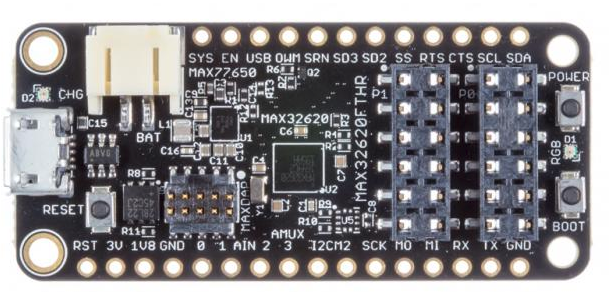Smarter, tougher, leaner MCUs for the IoT
Guest blog from Christine Young, Blogger, Maxim Integrated
When a smart, connected product can solve a problem in a way that is better than what we already have, that’s when the internet of things (IoT) really shines. For these products to flourish, the underlying microcontrollers (MCUs) must be power efficient, memory-rich, and secure.
Think about it: many of the IoT products coming into the market are powered by lithium-ion coin cell or similarly small batteries. Even so, these products, like hearables and wearables, are expected to deliver rich performance and functionality. This makes power efficiency an important criterion for longer battery life or to support more intelligent computation on an existing (and tight) power budget. More memory is essential, too, because it lets you build products that can run more complex applications, gather more sensor data, run multiple stacks, and so much more. For example, sensor nodes are collecting more data and, to make optimal use of available network bandwidth, are also doing more processing locally and making decisions without necessarily relying on the cloud to analyze the data and issue commands. The last criterion here, security, is one that shouldn’t be neglected, especially given all of the breaches that have occurred on networked devices deployed in the wild.
Many existing MCUs come with trade-offs that aren’t so appealing for the end product. Some deliver good power consumption but come with limited processing and memory capabilities. Many more are better when it comes to processing power but fall short in terms of power consumption or memory. Now, there’s a line of low-power MCUs that delivers the power efficiency, memory resources, and security capabilities needed by IoT designs. Maxim’s DARWIN MCUs provide:
- Wearable-grade power technology, including the lowest active mode and SRAM retention power available, to get the most from smaller batteries
- The biggest embedded memories in their class, so you won’t have to worry about running out of code space, processing SRAM, or adding another MCU
- A scalable memory architecture, so you can tap into external memory interfaces if you need it to run code from external flash or access external SRAM
- Advanced embedded security technology, including proven cryptographic engines and options for secure boot and IP protection
Design Contest Featuring DARWIN Development Board
Test your IoT design creativity in a new contest featuring one of the DARWIN development boards. The “Unleash Invisible Intelligence” design contest, sponsored by Maxim and Hackster.io, is based on ideas that can be turned into design prototypes using the MAX32620FTHR rapid development platform. The contest has a May 12 deadline for written proposals in one of these four categories:
- Sports and Fashion
- Smarter Planet
- Personal Safety Monitoring
- Home Control
Top entrants will receive their own MAX32620FTHR board and go on to prototype their design ideas and compete for additional prizes. Contest details are available on the “Unleash Invisible Intelligence” design contest page.
The MAX32620FTHR is a compact board that lets you quickly implement portable, function-rich, battery-optimized solutions based on the MAX32620 Arm® Cortex®-M4 microcontroller with floating-point unit. The board includes:
- The MAX77650 ultra-low-power PMIC based on a single-inductor, multiple-output (SIMO) architecture and featuring highly integrated battery charging and power supply. With its small size and high efficiency, this SIMO buck-boost regulator is ideal for low-power wearable applications. A 150mA LDO provides ripple rejection for audio and other noise-sensitive applications.
- The MAX17055 fuel gauge with ModelGauge™ m5 EZ algorithm. Featuring the industry’s lowest quiescent current, the IC’s integration of the ModelGauge m5 EZ algorithm means that it delivers high accuracy without battery characterization. This 7µA 1-cell fuel gauge IC combines the short-term accuracy and linearity of a coulomb counter with the long-term stability of a voltage-based fuel gauge.

MAX32620FTHR rapid development platform
The MAX32620FTHR can be a strong foundation for many smart solutions. Available in a 0.9in x 2.0in DIP form factor, the breadboard- and feather wing-compatible board features Pmod-compatible sockets including SPI, UART, I2C, and GPIO interfaces. At its core is the MAX32620 MCU, which is based on the Cortex-M4 with FPU. This MCU delivers high-efficiency signal processing, ultra-low power consumption, as well as ease of use. To optimize performance and power consumption for its target applications, it provides flexible power modes, an intelligent PMU, and dynamic clock and power gating. For high performance, internal oscillators run at 96MHz, and for maximum battery life (such as for always-on monitoring), they operate at 4MHz. An integrated hardware AES engine provides security. Use cases include fitness monitors, IoT sensors, portable medical devices, sensor hubs, sport watches, wearable medical patches, and other small, battery-powered products that you may be envisioning.
The MAX32620FTHR is Mbed Enabled, so getting started is a breeze once you have the hardware in your hands, and you can take advantage of all the libraries and support offered through the Mbed environment.
Can’t wait for the contest to get your hands on a board (or want to get started on your entry early)? Buy the MAX32620FTHR online for $20 from the Maxim website and get going today. Good luck with your design!
You need to log in to post a discussion
